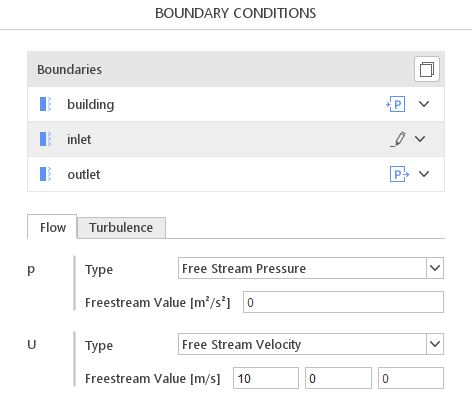Free Stream - Boundary Condition Description
Free Stream boundary condition specifies free-stream velocity and pressure in the so-called far-field boundary. The far-field region represents the area far from the object of interest, where the flow is undisturbed. This condition ensures that the velocity and pressure at the boundary remain constant and equal to the free-stream velocity. It is one of the most often used boundary conditions for external aerodynamics. It should be highlighted that Free Stream Velocity always goes together with Free Stream Pressure.
A huge advantage of this boundary condition is the fact that it can be applied to the inlet and the outlet of the flow domain, and it will automatically adjust the flow conditions based on the flow direction. Users, however, must keep in mind that this boundary condition should be used only far away from the object of interest, where the flow is undisturbed.
Free Stream - Boundary Condition Understanding Free Stream
This boundary condition is usually used when we want to calculate a flow around a certain object, like a wing or an airplane. Free Stream Velocity boundary condition, in order to work correctly, requires a large computational domain. In the literature, one may find recommendations saying the size of the domain should be around 50 to 100 times the characteristic length. The characteristic length may be, for example, a chord of the wing or length of the airplane - Figure 1.

The reason why the domain should be large is to make sure that the turbulent wake behind the object dissipates before reaching the domain boundaries. Otherwise, we could observe some reflections on the boundaries that might lead to the unphysical behavior of the model.
It should be noted that in SimFlow the users can find both Free Stream and Free Stream Velocity/Pressure boundary conditions.
Free Stream boundary condition work in the same way as Inlet Outlet - defines Zero Gradient when outflow on the boundary occurs and Fixed Value when inflow appears. This definition usually works well, but a problem appears when the flow becomes tangent to the domain boundaries.
Free Stream Velocity/Pressure is also based on Inlet Outlet boundary condition, but it introduces certain blending function that linearly varies between Zero Gradient and Fixed Value. As a result, we get more realistic velocity field predictions. The details are given below.
Figure 2 represents the boundary of the domain. We can easily imagine that in the presented region, the velocity might get tangent to the boundary. If the flow at one face changes from outflow to inflow, Inlet Outlet and Free Stream boundary condition will immediately switch to prescribed Fixed Value in the normal direction. Such a prescribed value most likely will be significantly different from the real velocity.

Free Stream Velocity/Pressure boundary condition introduces a certain blending function given by the equation below:
The graphical representation of the equation is given in Figure 3.

In the limit, when the flow is purely in the normal direction, the condition becomes either Fixed Value or Zero Gradient. Between these extremes, \(v\) is blended linearly for velocity, according to the equation above. When the blending function takes the value 0.5, it means that the flow is perfectly tangent to the domain.
Free Stream - Boundary Condition Application & Physical Interpretation
The Free Stream boundary condition is used for simulating flow around objects like wings or airplanes, requiring a large computational domain (50 to 100 times the characteristic length). It is used in many external aerodynamics related matters.
Car, Aircraft Aerodynamics
This problem can be solved by using simpleFoam solver. The Freestream boundary condition can be used to simulate the flow around a vehicle or aircraft, where the boundaries of the computational domain represent the free stream far away from the body.
| Physics | Velocity | Pressure |
|---|---|---|
Velocity Inlet | Free Stream | Free Stream Pressure |
| Tutorial | Description |
|---|---|
It simulates the two-dimensional flow around the wing’s airfoil. To enhance precision, the second-order velocity discretization method was implemented. |
Wind Engineering and Building Aerodynamics
In simulations of wind flow around buildings or structures, these boundary conditions can represent the undisturbed wind conditions at the domain boundaries.
| Physics | Velocity | Pressure |
|---|---|---|
Velocity Inlet | Free Stream Velocity | Fixed Flux Pressure |
| Tutorial | Description |
|---|---|
Simulation of carbon dioxide and ash particles released from a chimney into the atmosphere and investigating their dispersion in flowing air using species transport and Lagrangian particle simulation. |
Environmental and Atmospheric Flow Simulations
A steady-state, buoyant solver with Boussinesq approximation can be used to solve this type of problem - buoyantBoussinesqSimpleFoam. Freestream boundary conditions are useful in modeling atmospheric boundary layer flows or environmental dispersion where the domain boundaries need to reflect the undisturbed atmospheric conditions.
| Physics | Velocity | Pressure |
|---|---|---|
Velocity Inlet | Free Stream Velocity | Fixed Flux Pressure |
Velocity Inlet | Free Stream Velocity | Total Pressure |
Free Stream - Boundary Condition How to Use in SimFlow
The definition of boundary conditions in SimFlow is simple and intuitive. To specify the Freestream boundary condition, the user must navigate to the Boundary Conditions panel, select the appropriate boundary, and choose the correct option from the drop-down menu. It must be noted that the Freestream Velocity boundary condition should be selected for velocity, while the Freestream Pressure boundary condition should be used for pressure. These conditions are designed to be used together to ensure consistent and realistic simulation of free stream conditions.

Free Stream - Boundary Condition Free Stream - Alternatives
| Boundary Condition | Description |
|---|---|
prescribes normal gradient to zero | |
similar to |